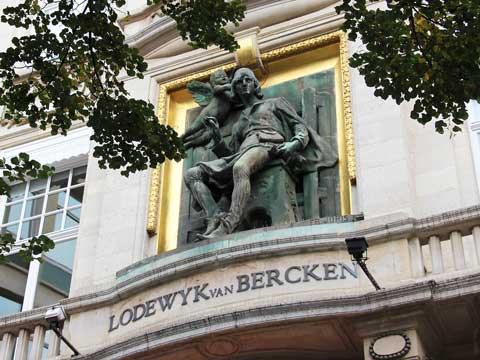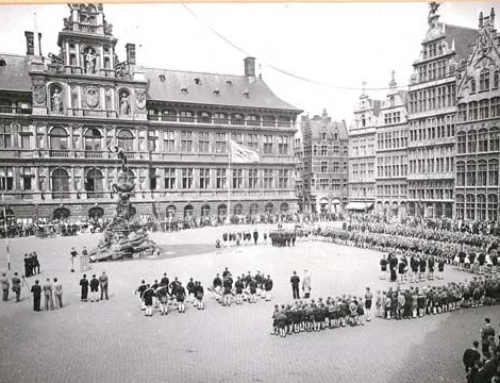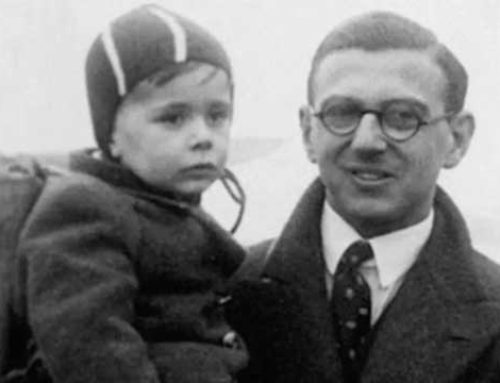Statue of Lodewyk van Bercken in Antwerp – image: Fred Romero
The credit for the invention of the scaif (a polishing wheel infused with a mixture of olive oil and diamond dust) goes to the renowned Lodewyk van Bercken, who introduced a practical tool for diamond cutters to unlock the hidden beauty of diamonds through faceting. Even in today’s modern polishing techniques, the concept developed by van Bercken over 500 years ago is still employed.
The exact moment when humans discovered that diamonds were the only material capable of polishing other diamonds remains a subject of debate.
However, it is known that early attempts at diamond polishing were rudimentary and relied heavily on basic tools. Diamond cutters used hand-driven bow drills and leather straps dipped in diamond powder. Due to the laborious nature of diamond polishing, it was often assigned to slaves and servants. Consequently, the earliest diamond jewelry primarily featured rough diamonds, with minimal polishing to smoothen surface imperfections.
This all changed with the invention of the scaif by the legendary Lodewyk van Bercken, which provided cutters with a practical tool to begin faceting diamonds and reveal their hidden beauty. Even in modern times, the polishing techniques continue to utilize the same concept devised by van Bercken over five centuries ago.
The initial design of the scaif consisted of a metal wheel rotated using a foot pedal. The wheel was coated with olive oil and suspended a fine diamond powder in the oil. Van Bercken discovered that by applying varying amounts of diamond powder at different points along the wheel’s radius, he could both grind the stone and achieve a smooth polish as needed.
Van Bercken, born in Bruges, Belgium, approximately 80 kilometers west of Antwerp, studied diamond cutting in Paris. By the mid-1400s, Bruges had emerged as a significant trading hub for diamonds, positioned at the end of the trading route originating from Venice.
As news of van Bercken’s invention spread across Europe, he received numerous requests from European nobility to manufacture diamonds for them. Recognizing the advantages offered by neighboring Antwerp, Van Bercken relocated there due to its inland water port, which facilitated the reception of visitors and goods.
At that time, Antwerp’s port handled 40 percent of the world’s trade, making it the transportation hub of Europe. Van Bercken’s presence in Antwerp and his success in establishing a diamond polishing trade played a pivotal role in transforming the city into the global center for the diamond industry, and he continues to be celebrated in Antwerp to this day.
As his reputation grew, he gained access to larger quantities of rough diamonds, enabling him to experiment and develop new cutting techniques. Van Bercken introduced the concept of absolute symmetry in the placement of facets on a stone. He was meticulous in his work and studied the refraction of light from the surface of a diamond, although he may not have fully grasped the dynamics of light refraction within the stone.
His efforts culminated in the invention of several new diamond cuts, including the pear shape. He also pioneered cutting a diamond into a briolette after observing similar shapes in precious gems from India.
His work laid the foundation for the earliest iterations of the modern round brilliant cut. Although his new diamond cuts undoubtedly surpassed anything previously seen in terms of beauty, not all customers were pleased with the outcome. In the absence of advanced tools like laser saws and computer-aided planning software available today, his innovative cuts resulted in a higher degree of diamond waste, reducing the final size of the gem. This was not always warmly received by his clients.
Van Bercken, being Jewish, faced restrictions on certain jobs and positions in the community at the time. However, diamond cutting was not subject to such obstacles, and he began training and teaching other Jewish students in the art of diamond cutting. He eventually established a guild for skilled diamond cutters in Antwerp.
The era was also perilous for non-Christians, but van Bercken found protection from Jacques Coeur, who held the position of master of the mint in France under Charles VII. Coeur, an influential trader of his time, introduced Van Bercken to many nobles who sought his diamond polishing services. Van Bercken played a significant role in establishing Jewish traditions within the diamond industry that persist to this day.
One of van Bercken’s most notable assignments was to cut three large stones commissioned by Charles the Bold, the Duke of Burgundy, in the 1470s. Among these stones, the most renowned is the Florentine Diamond, a nine-sided, 126-facet double rose cut weighing 137.27 carats, with a rich and storied history.
It is believed that Charles owned the diamond when he was killed at the Battle of Nancy in 1477. The stone was stolen in 1918 and smuggled to South America, where it was likely recut. The second stone, weighing 14 carats, was gifted to the Duke by Pope Sixtus IV. Van Bercken faceted the stone and set it in a gold ring for the Pope’s use during sacred functions. The third stone, initially misshapen, was skillfully cut by van Bercken into a triangular shape and placed in the center of two clasped hands, creating a friendship ring for the Duke. Van Bercken is also believed to have cut other significant stones, such as the Sancy and Beau Sancy, which were later named after Nicolas De Hardy, Lord of Sancy, as a tribute long after van Bercken’s death.
Antwerp pays homage to van Bercken with a statue of him in the port area, depicting him in his work attire while holding a diamond. Another statue can be found at the entrance to the ‘Meir’ shopping district in Antwerp, a short walk from the city’s diamond district. He remains one of the few working-class men in history to receive such an honor. Additionally, there is an Australian diamond jewelry retail brand that bears his name.







